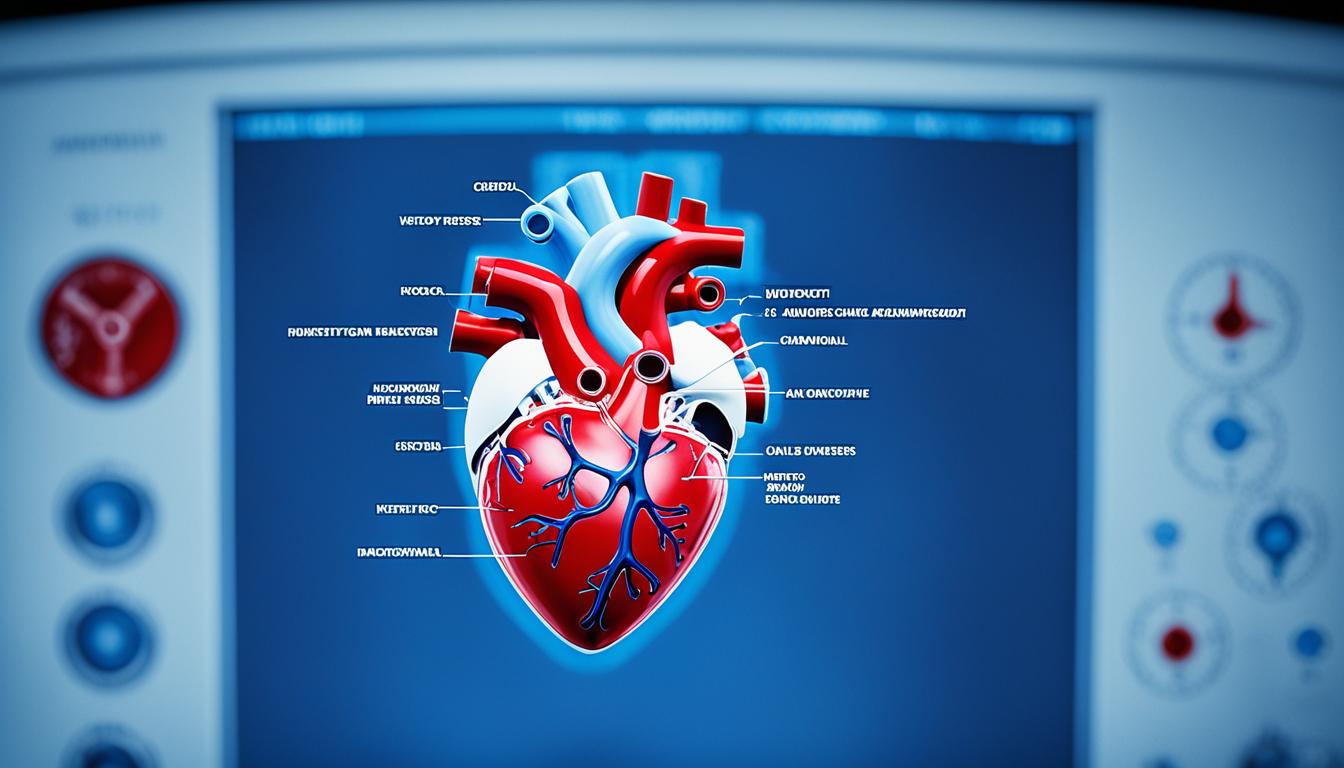Tricuspid valve disease harms the heart’s tricuspid valve. This valve is key in keeping blood moving between the right atrium and ventricle. Tricuspid regurgitation and stenosis can happen if the valve doesn’t work right.
When the valve doesn’t fully close, it lets blood go back into the atrium. This causes issues like feeling tired, hard to breathe, and swelling in the legs. If the valve narrows, it slows down blood flow which leads to similar symptoms.
The disease can come from birth defects, heart issues, or valve damage due to injury or infection. Tricuspid valve disease often shows up with other heart problems too.
Diagnosing it takes a careful look. Doctors listen for odd heart sounds and check for fluid signs. Tests like echocardiograms show the heart and its valves in detail. Sometimes, a catheter procedure might be needed to look at blood flow and pressure.
Key Takeaways:
- Tricuspid valve disease can manifest as tricuspid regurgitation or tricuspid stenosis.
- Common symptoms include fatigue, shortness of breath, and leg swelling.
- Causes can range from congenital defects to heart conditions and valve damage.
- Diagnosis involves physical examination, imaging tests, and sometimes cardiac catheterization.
- Stem cell therapy offers potential for regenerating damaged heart tissue and improving valve function.
Tricuspid Valve Repair and Replacement
Patients with severe tricuspid valve disease might be told about repair or replacement. Repair fixes the valve’s structure and function. This helps it close correctly.
Repair can include removing extra tissue or fixing the valve. It can also involve using artificial parts. This aims to make the valve work normally again. Replacement removes the bad valve and puts in a new one. This new valve could be mechanical or biological.
These procedures are hard because of the valve’s complexity. But, surgeries are getting better. People now have a higher chance of doing well after repair or replacement. They also have fewer problems in the long run.
Benefits of Tricuspid Valve Repair and Replacement:
- Improved valve function and closure
- Alleviation of symptoms associated with tricuspid valve dysfunction
- Enhanced overall heart function and cardiac output
- Better quality of life for patients
- Reduced risk of complications
- Long-term survival benefits
Thanks to surgical progress, patients with this disease have better options. They can improve their life and health for the long term.
| Procedure | Description |
|---|---|
| Tricuspid Valve Repair | Surgical intervention to correct valve structure and function, involving techniques such as removal of excess tissue, repair of the existing valve, or use of artificial materials to reconstruct the valve. |
| Tricuspid Valve Replacement | Surgical removal of the damaged valve, followed by the replacement with a mechanical or biological valve. |
Transcatheter Tricuspid Valve Therapy
In recent years, there has been big progress in
transcatheter tricuspid valve therapy
. It offers patients with
tricuspid valve disease
a better way for treatment. This new approach uses thin tubes to reach the heart. Then, doctors place devices or use methods to fix the tricuspid valve.
A key tool in this therapy is the
MitraClip
. It helps the valve work better by joining its parts. This method doesn’t need big cuts like surgery. So, it makes recovery faster and lowers the chance of problems. That means patients have a better
prognosis
and life quality with this treatment.
Teams are still working on new devices for this kind of therapy. These new tools could make patient results even better. They might change how tricuspid valve issues are treated in the future.
For a full look at transcatheter tricuspid valve therapy, check the table below. It compares different methods being used:
| Treatment Option | Procedure | Benefits |
|---|---|---|
| Transcatheter Tricuspid Valve Repair (MitraClip) | Catheter-based clipping of tricuspid valve leaflets | – Minimally invasive procedure – Improved valve function – Reduced regurgitation |
| Percutaneous Tricuspid Valve Replacement | Catheter-based placement of a mechanical or biological valve | – Less invasive alternative to open-heart surgery – Improved valve function and durability |
| Emerging Technologies | Novel devices under evaluation for percutaneous tricuspid valve therapy | – Potential for further advancements in treatment – Enhanced patient outcomes |
As transcatheter treatments get better, the field of tricuspid valve care moves forward. They give patients new hope and better options than older surgeries. This progress is a big change in how tricuspid valve problems are handled, making lives better.
Conclusion
Tricuspid valve disease is a serious issue affecting many people’s lives. But, recent treatments like stem cell therapy, tricuspid valve repair, and transcatheter tricuspid valve therapy bring hope. Stem cell therapy aims to fix heart tissue and mends valve function. Surgeries like tricuspid valve repair or replacement can greatly help those with severe tricuspid issues. Also, transcatheter procedures are less taxing, cutting down recovery times.
As knowledge grows and tech improves, the outlook for patients with tricuspid valve disease gets brighter. This era in the field is thrilling, as new methods and devices keep popping up. Stem cell therapy and transcatheter procedures are getting better and better. This means more hope for those struggling with tricuspid valve problems. They get a chance to better their health and live a fuller life.
Pushing forward, supporting more research and teamwork is key. This would increase our know-how and how we treat tricuspid valve disease. With effort, we’re aiming for outcomes that really change patients’ lives. The future is optimistic as we join forces to push tricuspid valve disease care toward more tailored and effective solutions.

